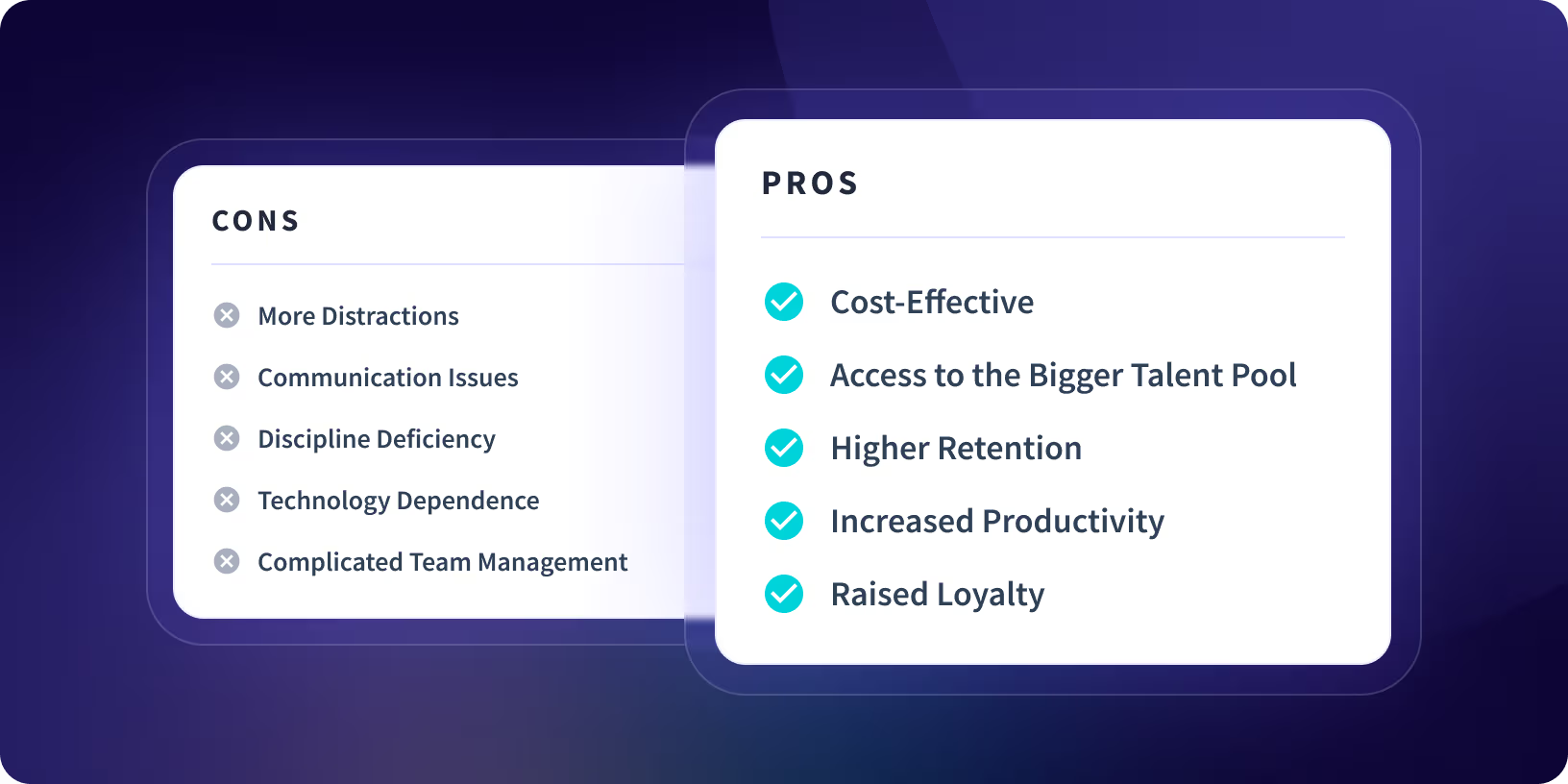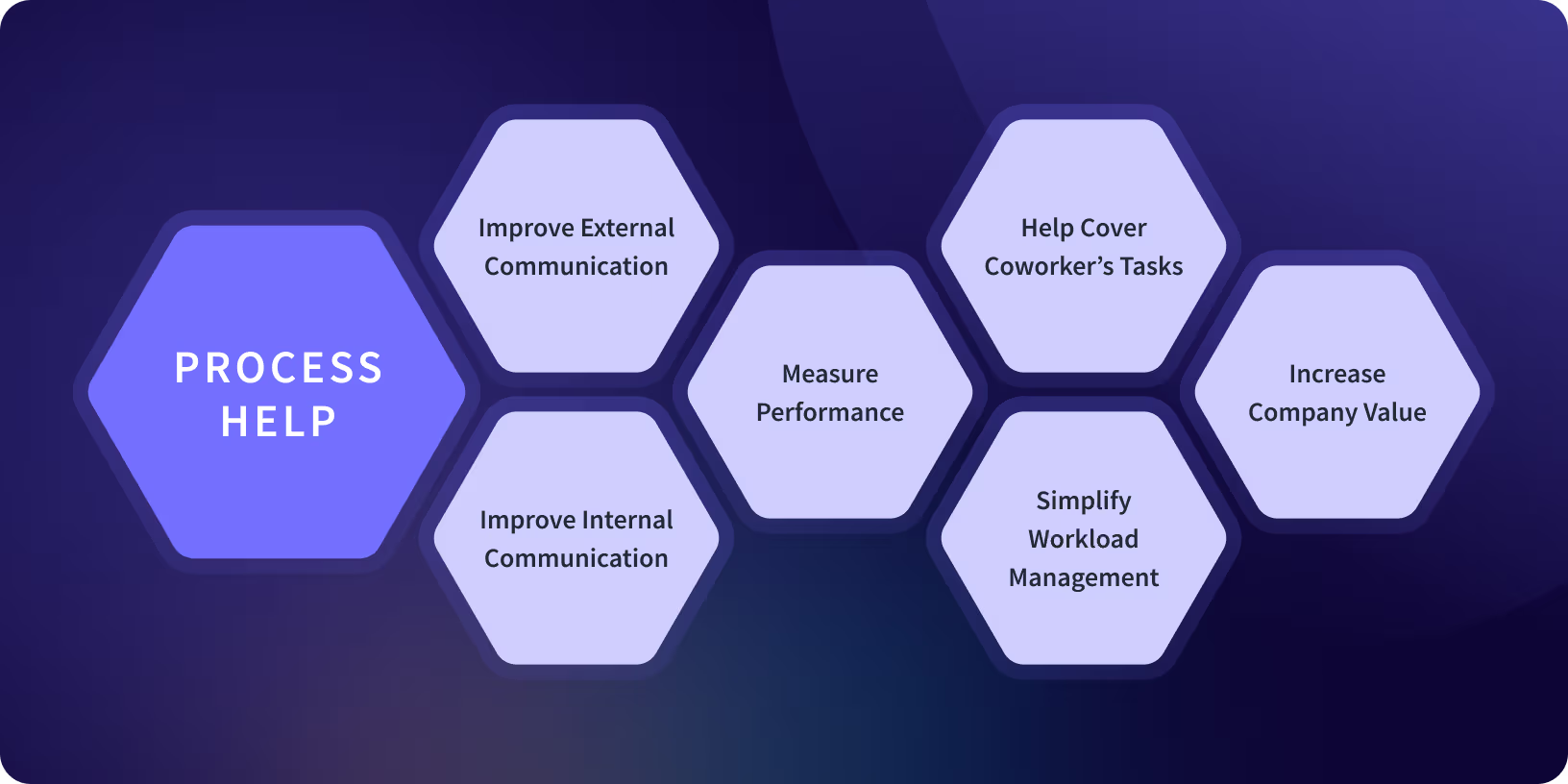The Ultimate Guide to Creating and Managing a Remote Team
Are you thinking of starting a remote team?

{{cont-top}}
01: Introduction
Research shows that 44% of global companies allow remote work to some extent, while 16% of them are fully remote. If you haven’t already, you’ve probably thought about hiring someone remotely, or allowing team members to work from home, at least some of the time. And it’s completely understandable, as there are many perks to hiring outside of your locale, or allowing employees to work remotely.
Since remote work is only going to become more popular as time goes by, we decided to create an ultimate guide for any company that wants to experience its benefits.
In this guide you’ll learn everything you need to know about managing a remote workforce. Additionally, we’ll share results from our eye-opening The State of Remote Work Report 2022: How Companies are Preparing for the Future of Work to reveal how leading companies are going remote.
{{divider-1}}
02: Remote Team Challenges and Solutions
Remote work comes with many challenges - both for workers and for employers. All of these can be tackled, but it’s important to be completely aware of how remote workforce management looks like, and what it can bring to the table..
[fs-toc-omit]Time Zone Issues
One of the primary challenges that needs navigating is, of course, time zone issues. You might have employees working in the Pacific time zone, while others are in a popular remote work location like Lisbon, Portugal. That’s an eight-hour difference that might be tough to overcome.
Besides producing communication issues, different time zones can cause delays in production, delivery and project completion. Having people respond to questions after eight hours will certainly slow down any tasks your team is trying to complete.
To overcome this challenge, you can either hire people who are in the neighboring time zones, set schedules to ensure some daily overlap, and organize staff meetings only when everyone's working.
[fs-toc-omit]Data Security
Making sure your data is secure can be a complicated matter if your employees are halfway across the world.
Even with everything in the cloud, a rogue employee can still download excessive amounts of data maliciously or simply innocently access it in an insecure manner, say on a public network.
[fs-toc-omit]Language and Cultural Obstacles
Having a globally diverse team is great, until those differences become obstacles. Almost every country in the world has different customs, so it’s inevitable that at some point this will cause an issue.
[fs-toc-omit]Are My Employees Working?
This is a question most business owners ask themselves. However, it might be even more prominent in the remote environment. When people are working from home, rather physically in front of managers in the office, there may be a higher perception that employees are wandering into the world of memes and videos, rather than working.
Luckily, there are various remote monitoring software options available, which can help you manage your team’s performance from afar(we’ll talk more about the options later).
{{divider-3}}
03: Pros and Cons of Having a Remote Workforce
Like you’ve seen, remote team management comes with its challenges and cons, but, arguably, these are far outweighed by the benefits of having a distributed workforce:
- It is cost-effective since you’re cutting down on office space, office equipment, furniture, etc.
- You get immediate access to a worldwide talent pool as you’re not limited by location.
- Remote teams have higher retention stats, as 8 out of 10 remote employees are happy with their job.
- 77% of remote workers reported they became more productive since they started working out of office.
- In the end, 79% of workers agree that they would be more loyal to an employer who offers flexibility.
Besides the challenges we listed above, there are some more cons to remote team:
- Employees could be more distracted because there’s way more distractions at home or in a coffee shop than in an office.
- Communication issues can arise due to lack of clarity, diversity, and improper tools.
- Remote workers could be harder to discipline since they’re living halfway across the world.
- With remote teams, you’re heavily relying on technology, and if something breaks down you could lose hours or days before its fixed.
- Team management gets complicated as your team keeps growing because you need to keep track of 50 people in 50 different places. Keeping track of everyone’s working hours, vacation days, payrolls, etc. won’t become easy all of a sudden.
Additionally, if you need to travel and you don’t want to lose vacation days, you can just carry your laptop with you and work from wherever you’re spending your time off.

{{divider-3}}
04: What’s in it for Employees?
Now you know what’s in it for you, and how your business can benefit from having a distributed team. However, what you should also know and keep in mind is the fact that employees benefit from working remotely too.
Employees love remote work because it gives them flexibility. They get to choose where to work from, and often when to work as well. It’s a great benefit for people who have long commutes to work, or working parents who would like to spend more time with their family.
Remote work also means less costs for the employee, as they don’t have to spend money on trains, buses or gas. Working off site might be good for your health as well, since working from the comfort of home can have a positive effect on stress levels.
{{quote-11}}
{{quote-1}}
{{quote-2}}
{{quote-3}}
{{quote-4}}
05: Where to Look for Remote Workers?
Given how popular remote positions have become, we have tracked a marked increase of remote positions on online job boards, as well as in social media pages/groups that are fully dedicated to helping remote companies find workers.
Aside from the above job boards, finding freelancers or even full-time employees can be done through platforms like Upwork, Freelancer or Fiverr.
However, if you prefer using traditional platforms for job seekers, you can always post a remote job there, or even look for talent on LinkedIn.
{{divider-5}}
06: What to Look for in a Remote Employee?
When you’re looking to hire remotely, you should be aware that not everyone works well in such an environment. If you’re taking your first steps into remote work, we recommend that you try and hire someone who already has experience working remotely. This will take some of the uncertainty out of making your first remote hires. That’s because working from home comes with many challenges, and not everyone can cope with them.
For the most part, hiring remotely stays true to the principles of hiring someone for an office-based role. So, imagine you’re hiring someone to work in the office with your team; they should have the skills you need and match your culture, but they also need to be even more independent and proactive than your other team members. Additionally, their communication skills should be top notch since your collaboration will depend on them.
{{quote-5}}
07: Onboarding Process
When onboarding new employees who are working in the office, you usually show them around the place, let them meet the whole team, and hang out with everyone. Maybe you even have a buddy system, which helps new recruits adapt to work more quickly. Depending on the position, there might be some training involved for the first few days, or weeks. The important thing is that your new employee has someone to talk to during their first weeks, and that they’re in constant communication with their managers and colleagues.
{{quote-6}}
Things are a bit more complicated with remote workers. It’s not easy keeping them on the line for the whole day so they can ask questions and hang out with new coworkers.
When welcoming new telecommuters, you should try and have as much face-to-face time as possible with them. They should be included in meetings, meet the team through a video conference, and get acquainted with everyone’s roles.
{{quote-7}}
08: Paying Remote Workers
One huge concern among employers who are looking to hire remotely are the payments. How can you pay remote workers? Plain old bank transfers might do just fine. However, depending on where you and your workers are located, this might not be completely legal in the event your worker isn’t registered as a business entity. Make sure you’ve consulted local lawyers and accountants to get your ducks in a row before you start making payments.
In most cases, remote employees who are working for a company full-time are self-employed. Therefore, the company they work for is paying for their taxes, healthcare, social security, and any other costs which are required by the law in remote workers’ countries.
Since remote work and freelancing are at an all time high right now, there are many payment services that are favorable for you and for employees. Some of which are cheaper than regular bank transfers. These services, like TransferWise and Payoneer, will take a commission fee either from you or from the employee, so make sure to double check these additional costs.
{{divider-8}}
09: Embracing the Technology
Technology allows you to have remote workers, so why not use it to your advantage? There’s a set of various tools you’ll need to keep everyone in the loop, and maintain healthy relationships among team members.
Look at it this way: the technology you’re using is like the glue that’s keeping your company together.
In the following section you'll read about all remote team management tools you'll need once you switch to a distributed environment.
{{quote-8}}
[fs-toc-omit]Communication Tools
Apps like Slack, Google Hangouts, Skype, or any other app of your preference that will make daily communication easier. The software you select should have the ability of video conferencing so you can get as much face-to-face time as possible with each employee.
[fs-toc-omit]Collaboration Tools
Cloud-based docs, sheets, presentations, design or video editing tools will make it easier for your team members to work together. Some of them might be a bit costly, but it’s the simplest way to keep everyone on the team involved.
[fs-toc-omit]Project Management Software
Trello, Asana, Jira are just some of the apps you can use to manage projects and tasks on your team. Everyone can mark finished tasks, add new ones, and you always have an overview of what’s in the pipeline for every department.

[fs-toc-omit]Good Connection and Quality Equipment
Depending on your budget, you can provide funds for better internet connection and more suitable equipment to your remote employees. It’s a bummer (and very unprofessional) when meetings break up due to poor connectivity.
[fs-toc-omit]Time Tracking and Employee Monitoring Tools
By using remote employee monitoring software or remote time tracking software you can always be sure your team is staying productive and efficient. While monitoring tools provide you with info about what they’re working on, a time tracking application can give you insight into how many hours they’ve actually worked and help you pay them fairly.
[fs-toc-omit]Good Connection and Quality Equipment
The health of your employees should be one of your priorities, wherever they’re located. However, it seems that healthcare and insurance are a big pain for people hiring nomads and remote workers. SafetyWing helps you with this issue by providing all kinds of medical and travel insurance for your employees.
{{divider-3}}
10: Building a Company Culture in a Remote Team
Company culture is a hot topic in remote companies, because it’s much easier to build a culture in co-located teams. Co-located teams can work on their culture between tasks, as well as by organizing various after-work activities.
The first thing you have to know is that it’s going to take more conscious effort to establish a culture in a distributed team.
Culture is about more than group activities, it depends on the way your team members work, collaborate, communicate and depend on each other. So, in a remote environment, this is where your culture-building focus should be placed.
This doesn’t mean that you should forget about getting the whole team together every once in a while, or that you shouldn’t give back to the communities where your people are located. It’s simply an acknowledgement that remote culture building requires a slightly different approach.
{{divider-10}}
11: Keeping Employees Engaged
Employee engagement needs to be carefully maintained each day, and there are several things you, as a manager, can do to help out.

[fs-toc-omit]Regular Team Meetings
Organizing regular team meetings in which everyone participates. Depending on your company’s structure these might involve the whole company, or separate teams. It’s important to set aside an hour (or even more) every week, month or quarter (whatever works for you) to sit down and talk to everyone. Share new ideas, discuss progress, problems, celebrate success and everything else in between.
Additionally, you can take 5-15 minutes per day to do a short briefing once everyone’s in, just to get everyone up to speed on that day’s tasks.
[fs-toc-omit]One on One Meetings
Besides talking to the whole team at once, it’s important you take the time to talk to each employee separately. Having monthly discussions about their progress, improvement opportunities, and any concerns is beneficial for you, as well as for your employees.
If your workers are dissatisfied about something, they’ll be able to voice their opinion, and it will give you great insight into what can be improved within the company.
[fs-toc-omit]Promote Transparency
It’s easy to stay in the dark when you’re halfway across the world from the rest of the team. That’s why you should make an effort to notify everyone about all the things that are changing. It only takes a few minutes of your day, and it can make or break your team.
Transparency should also be incorporated into relationships among team members, not just the management and employees. All workers should be able to talk openly about any issues or challenges they’re facing, and it’s your job to lead by example and show the whole team that openness goes a long way.
[fs-toc-omit]Watercooler Chat
It’s impossible to chat with your coworkers while you’re making coffee or prepping lunch in a distributed environment. However, given that you’re using a communication software, you should create a channel or a group chat that will be used to share memes, discuss the new episode of everyone’s favorite TV show, or just to share personal news.
The team functions when people make friends within that team, and it’s highly unlikely anyone will make a friend if they’re only talking about work.
[fs-toc-omit]Team Retreats
Everyone loves to travel, and team retreats are a perfect opportunity for everyone to meet, hangout and collaborate. Additionally, it’s a once-in-a-lifetime experience to spend a few days with your team in another country.
Want to know more? Learn how to measure remote employee engagement properly.
{{quote-9}}
12: How Can You Keep Remote Workers Motivated?
We can’t say this enough times, but communication really is the key to successful remote teams. It’s like with long-distance relationships - trust and communication go a very long way. So it shouldn’t come as a surprise that regular communication is also how you keep your distant employees motivated and engaged.
Besides that, an employee recognition program is a great option to motivate remote teams! It can include praises, gift cards or any other incentives.
It’s important you don’t forget that your remote employees also have aspirations and a wish to be promoted at some point. Offer growth options, further development, courses, additional training - anything your employees need to become better at what their doing.
{{quote-10}}
13: Handling Conflict in Distributed Teams
Company culture is a hot topic in remote companies, because it’s much easier to build a culture in co-located teams. Co-located teams can work on their culture between tasks, as well as by organizing various after-work activities.
The first thing you have to know is that it’s going to take more conscious effort to establish a culture in a distributed team.
Culture is about more than group activities, it depends on the way your team members work, collaborate, communicate and depend on each other. So, in a remote environment, this is where your culture-building focus should be placed.
This doesn’t mean that you should forget about getting the whole team together every once in a while, or that you shouldn’t give back to the communities where your people are located. It’s simply an acknowledgement that remote culture building requires a slightly different approach.
{{divider-13}}
14: Processes, Processes, Processes
Clear processes are the oil that keeps your company running. And if you have clear, outlined processes and procedures in your office, why wouldn’t you have some for your distributed teams?
It might take time and money to develop all procedures, and it will definitely take time for your employees to get used to the new rules. Additionally, your new employees will settle in much quicker, since everything they need to do will be presented to them in a neat form.
Written processes are important because they help out your business in numerous ways:
- Improving internal communication - which is, like we said, one of the most important factors of successful remote teams
- Improving external communication
- Simplifying workload and workflow management
- Providing a baseline to measure performance
- Helping employees finish tasks when the person in charge is not working
- Providing a baseline to measure performance
- Increasing company value if you choose to sell the business
It might take time and money to develop all procedures, and it will definitely take time for your employees to get used to the new rules. Additionally, your new employees will settle in much quicker, since everything they need to do will be presented to them in a neat form.

{{divider-14}}
15: Dealing with Growth
It’s easy for CEOs to talk to everyone regularly, and oversee all changes when you have a small team. As the team grows, it will be harder to stay on top of everything that’s happening in each department, which is why you need to embrace a few changes.
[fs-toc-omit]Implementing Structural Changes
At the point when you have 10 or more people in your team, you can start differentiating the departments. Your job is to empower your team members to be more independent, to take charge and make decisions – even the big ones!
Create an organizational structure. Make sure everyone is aware of their duties and tasks. Additionally, all workers should know who to go to when they need assistance with a certain aspect of their process.
The point of structural changes is for you to stop being involved in every little aspect of your business, and let someone else take the lead.
[fs-toc-omit]Adaptability
Adaptability is a virtue, and if you’re looking to succeed in any kind of business, you need to have it. Accommodating new tech is the first step.
As your team grows, the tools you’re using (or plans) might not be able to handle the number of workers you have. You can anticipate problems, or bigger costs for any of the subscriptions you have.
[fs-toc-omit]Preventing Burnout
Researchers define burnout as a psychological syndrome emerging as a prolonged response to chronic interpersonal stressors on the job.
Dynamic, growing environment makes you feel like you have to handle everything yourself, and if you’re doing this you have to be prepared for a burnout. But it’s not only your burnout you need to think about - your employees could be stressing out and feeling overworked as well.
Dynamic, growing remote environments can make you feel like you have to handle everything yourself, which can lead to burnout if not managed properly. But it’s not only your burnout you need to think about -- your employees could be stressing out and feeling overworked as well if work and life get too intertwined.
The first step towards preventing burnout is to make sure your team can handle the current workload.. If your team is struggling with work, it’s obvious they either don’t have enough time to handle the tasks, or they’re not properly equipped. Organize a meeting to discuss these issues, and if your team feels like more people would help out, estimate your budget and start hiring. On the other hand, maybe your employees don’t have enough knowledge or tech to perform in a better way. In which case you should invest in courses, training, or maybe even new hardware and software.
Additionally, you can incorporate awesome practices into your culture like mental health days, unlimited vacation, allowances for gym or spa memberships, etc.

{{divider-15}}
16: Awesome Stats About Remote Work
We’ve already mentioned some remote work stats in the beginning of this guide, however, we thought it would be good to share some numbers which could be considered unusual and offer some explanation behind them.
For more stats about remote work, check out our state of remote report.
- 29% of completely remote companies are led by women. They either have female CEOs, founders or presidents (to give you some perspective, only 17% of startups in the overall business community have a female founder)
- Remote workforce has grown by 140% since 2005
- 90% of remote workers plan on working remotely for the rest of their careers
- 55% of hiring managers agree that remote work among their full-time employees is becoming more common, and they expect 38% of their workers to be remote within the next decade
- 58% of remote employees said remote work improved their motivation
- 28% of remote workers describe themselves as introverts; 38% say they’re ambiverts, while 34% identify as extroverts
{{divider-15}}

Disclosure: The fact that the companies below participated in the guide doesn't mean that they are affiliated with our products, or other products from the time tracking/monitoring industry.
PLEASE NOTE: This page is just a preview of The Ultimate Guide to Creating and Managing a Remote Team. To access the FULL guide click here.
As a working mom it gives me greater flexibility and saves me time by not having to commute.
Living in a big city, remote work gives me time I’d normally spend on stressful public transit to take care of myself: go to the gym, cook at home, play with my cats. Working remote also means that I get complete control over my environment and I can tailor it specifically to the things that make me most productive. I get a lot more quality work done this way, with less stress in a shorter period of time.
I feel very grateful for the people remote work connects me to. It brings incredible people together who otherwise wouldn’t have an opportunity to connect. I feel that it allows a lot of different perspectives to contribute towards a common goal, and doesn’t limit the pool of coworkers you might have to just one location. I feel lucky I can travel as needed to be with family/friends and still be able to work, have more opportunity to focus on health/wellness with the time I save commuting (or you know, putting on ‘real’ clothes :) ), and adjust my hours as needed for appointments, etc.
As a military family, remote work has allowed me to maintain a consistent career despite our frequent moves. Without the freedom to work from anywhere, I’d be forced to “start over” every few years. I’m incredibly grateful that instead, I can continue to grow in my role and work alongside amazing teammates from around the world from wherever we are.
“I would say self-discipline and managing one's own psychology.
No amount of communication tools will replace the daily interaction you have when you work in an office, thus remote work requires some getting used to. If the candidate has prior remote experience, it's great, but usually that's not the case. I prefer talking with candidates openly about all ups and downs of remote work during the hiring process. The reactions and feedback I get when I talk about the ups/downs are important.
The second point is about self-discipline. Even if you work for another company, in remote work you are very much your own boss. Sure, you report to and work with others, but you don't usually have the peer pressure environment that an office has which is the source of discipline for most people. Ability to plan and manage your time without someone over your shoulder is very important.
Neither of these qualities is easy to judge by online calls you have with candidates, but over time you build a pretty good understanding. Other than these, remote work is still work so you look for the analytical thinker, cultural fit and overall best person for the task. Luckily the world is full of great people to work with!”
“Camplight is an invite-only cooperative. On the one hand, our onboarding process is concerned with seeing whether we can collaborate effectively with the onboardee. On the other hand, we try to understand whether it’s okay for them to get closer to the “fire”. Given that, I think the most crucial part in the onboarding process is whether the core team has no objections against the person in question.
This gathering of objections is the very last step of our onboarding process. The person who guides the guest to the way we work, creates an initiative in which they ask whether everybody is okay for the onboardee to join the core team. If someone has arguments against this, we drop the invitation and may consider it again later.
Of course, sometimes a person who was invited decides to leave the cooperative after a while. Despite that, keeping Camplight invite-only and focusing mainly on whether we’d like to work with a given person has made it possible to grow strong relationships within.”
“At Giant Swarm, the onboarding process starts the moment you sign your contract. This is when you’re introduced to your personal buddy - a person holding the same position and your go-to person for all questions that might come up. On your first day, you’ll virtually meet with your buddy and People Ops to go through the initial steps, with regards to admin issues, which meetings to attend, how to get started, where to get all the info/training you’ll need.
This is followed up by very regular meetings both with your buddy as well as People Ops, initially, these meetings are quite frequent and then fade out over time. During the first couple of months every new team member schedules a 30 min. 1:1 session with every single person within the company, with the aim of getting to know each other on a more personal level, before eventually meeting everyone in person at one of our two off-sites per year.
A quarterly “New Bee” Retrospective meeting which all new team members attend twice ensures that our onboarding process is refined over time, and that issues are addressed as soon as possible. Additionally, we’ve created an “ask-me-anything” channel on Slack where all questions from admin to deep tech questions can be asked, but of course, the whole team is always happy to help out.”
“As a fully remote team spread across 4 different time zones we need to be really engaged with the tech tools that we use. Communication is always key to ensuring that any team remains productive, happy and focused. This is particularly true when you don’t sit in the same office and sometimes work completely asynchronously. Of all the tech tools we use at Designlab to stay connected, here are the ones we just can’t do without:
Asana - Asana is our planning and project hub. We use it to make sure that we are all working on the most important things at the right time in our planning and execution cycle.
Slack - Slack is where the bulk of our communications happen. We use it to ask questions, share information, connect with one another about work or common interests. In many ways, it is our equivalent of a quick tap-on-the-shoulder chat.
Zoom - As a remote team we don’t often get to sit around a table together when we meet but using Zoom for our video calls has meant this is not a problem.
Airtable - We work with a lot of data which at times can feel overwhelming.
Airtable helps us to organize our data in myriad useful ways.
Guru - Sharing information is pretty crucial to creating effective processes and providing a seamless customer experience. We use Guru to ensure that all the process, product and system information we need exists at our fingertips and not only in the heads of our experts.”
“For a fully integrated, cohesive team that is used to collaborating over video calls and Slack messages - having one or two designated times a year where they can interact in person is invaluable.
This is the time where coworkers can see each other as more than just coworkers, and for managers to see the small unique traits that make their teams do what they do best. It’s also a great relevancy tool for peer-to-peer relationships. For example, maybe two members of your team haven’t been seeing eye-to-eye on collaborating on a key project. After spending time together at a retreat, they may have a deeper understanding of each other's communication style, leading to a breakthrough in looking at the same challenge through a new lens.
For companies looking to implement a team reunion or retreat - the key step to planning is making the retreat or reunion work for your particular team. Throughout your planning, make sure to circle back to the ROI on the activity, the meal, the agenda. Make sure that you not only communicate the broad purpose of the trip but also that these are activities that your team is interested in. Especially if the trip has minimal direct work-related sessions (and is heavy on the intrapersonal bonding and “fun” events) it will be a key driver for success if you openly share with your team the purpose behind that escape room, horseback riding session, or brewery tour. That purpose is to recalibrate as people and to know each other better in order to tackle more complex business challenges in a unified front.”
At OnTheGoSystems we believe that to get the best out of people it is important to truly know them. To know what gets them motivated, how they like to work and what their interests are. People are not simply faceless employees. Many of them will prefer to work in different ways. It is our job to understand that and to get the best out of them in a way that works for the company and for each of them.
Treating our team as people, not just employees
For example, our company offers an annual scholarship program in which we provide a bursary for each person which they can spend on some physical activity of their choice or on learning a new skill. If people are constantly pushing themselves both physically and mentally in it can only have a positive impact on their work.As our motto goes, “Happy people make great products.”
Our company is your company
We believe it is important that everyone at the company feels it is their company. Regardless of which team they work in, we want them to know that they are having an active input in OnTheGoSystem’s direction.
We are transparent. We show everyone all that goes on behind the scenes. We have recurrent updates with the whole company where we show where we stand financially and discuss what our company goals are. When we attend WordCamps, WordPress Meetups or any other professional events we want our team to be proud to represent us. We achieve this by supporting each other and showing respect to everyone who works at the company.
Getting the best out of each other
Our jobs are challenging and fast-paced and, even if they’ve spent years at the company, there are always times when members of our team are not sure how to complete a new task. That’s why we make sure people feel comfortable enough to ask for help from their peers.
You should not be afraid to say “I don’t know how to do it.” There will always be someone who can teach you and help you provide an answer to your problem.
People are also motivated if they are given the freedom to choose how they get their work done. We are a great believer in providing flexibility to our team members.
As well as choosing how they work we believe it is important to give people the freedom to pursue new, challenging tasks. Performing the same work each day is a recipe for boredom which affects productivity. Therefore, we encourage people and teams to take on various roles.
Thank you
Special thanks to everyone who participated in this guide, and shared their experience with leading a remote team.










